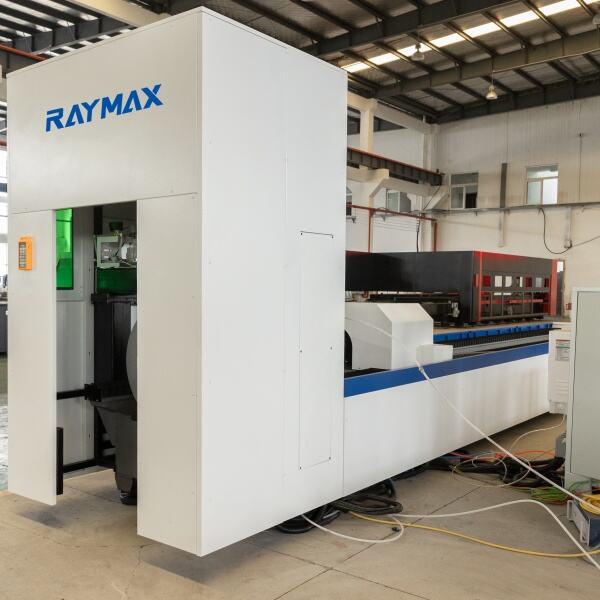Peran Sistem Pendingin dalam Mesin Pemotong Laser Serat
Mencegah Overheating dalam Operasi Berdaya Tinggi
Sistem pendingin dianggap penting untuk mengatur panas yang dilepaskan dari area pemotongan dalam aplikasi pemotongan laser berdaya tinggi, di mana suhu dapat melebihi 300°C. Laser Institute of America telah melakukan penelitian yang menunjukkan bahwa pendinginan yang baik dapat mengurangi kemungkinan kesalahan yang terkait dengan overheating hingga 70%. Hal ini penting karena overheating dapat mempengaruhi kualitas potongan dan menghambat mekanisme penghilangan material. Mesin didinginkan dengan kombinasi air dan udara, sirkulasi yang secara perlahan mendinginkan interior mesin dan mencegah tegangan yang sering disebabkan oleh panas, sehingga kinerja operasional secara keseluruhan selalu optimal untuk berbagai aplikasi pemotongan.
Memelihara Ketelitian Pemotongan yang Optimal
Ekskursi termal dapat mengurangi akurasi laser dan menyoroti perlunya pendinginan yang stabil untuk mempertahankan presisi. Kontrol suhu yang baik memberikan akurasi pemotongan hingga 30% lebih tajam. Sistem pendingin yang terawat dengan baik menjaga suhu optik pada sistem pengiriman berkas laser tetap ideal, sehingga membantu mengurangi distorsi termal. Metode seperti pendinginan lensa aktif sangat penting untuk menjaga stabilitas fokus karena titik fokus tersebut diperlukan untuk mencetak fitur-fitur yang sangat kompleks dan akurat dalam hfm.
Memperpanjang Umur Sumber Laser
Pentingnya sistem pendingin tidak hanya terbatas pada optimasi kinerja: sebagian besar waktu, sistem pendingin yang baik dapat menggandakan usia sumber laser apabila dilakukan pemeliharaan yang tepat. Data contoh dari National Laser Users' Facility menunjukkan bahwa semakin sedikit waktu laser tidak terpakai karena pemeliharaan, semakin efektif pula pendinginan yang kita lakukan. Pengetahuan dan penerapan teknik manajemen termal yang tepat dapat berarti penghematan biaya yang signifikan dalam jangka panjang, yang pada gilirannya mengurangi biaya perbaikan dan penggantian sambil mempertahankan kinerja optimal mesin pemotong laser serat.
Jenis-Jenis Sistem Pendingin Laser Serat yang Dijelaskan
Sistem Berbasis Air vs. Sistem Pendingin Udara
Sangat penting untuk mengetahui perbedaan antara sistem pendingin berbasis air dan udara agar Anda dapat menentukan pilihan pendinginan terbaik untuk mesin pemotong laser serat Anda. Meskipun demikian, sistem pendingin berbasis air juga umumnya dianggap efisien karena memiliki kapasitas transfer panas yang tinggi, dan konon dapat mencapai efisiensi hingga 50% lebih baik dibandingkan sistem pendingin udara. Pada situasi di mana sejumlah besar panas perlu dibuang, sistem semacam ini seringkali menjadi pilihan yang diinginkan. Di sisi lain, pendingin kering dihargai karena kebutuhan perawatannya yang rendah serta ukurannya yang kecil, sehingga memungkinkan pemanfaatan ruang secara optimal untuk instalasi yang terbatas secara lingkungan atau pendinginannya. Pada akhirnya, pemilihan antara kedua sistem ini biasanya akan bergantung pada harga mesin pemotong laser serat dan kebutuhan operasional spesifik Anda, sehingga sangat penting untuk mempertimbangkan kedua elemen tersebut saat memutuskan mana yang akan dibeli.
Pendinginan Hibrida untuk Kebutuhan Efisiensi Tinggi
Sistem pendingin hibrida (HCS), kombinasi antara desain udara berpendingin air dan berpendingin air, memenuhi kebutuhan efisiensi tinggi dengan fleksibilitas dan keseimbangan. Mampu menangani siklus kerja tinggi dan kecepatan pemotongan yang lebih tinggi, sistem ini memastikan tidak ada penurunan performa akibat panas berlebih. Penggunaan bersama dua teknik pendinginan ini meminimalkan tegangan termal dan memungkinkan produktivitas yang berkelanjutan. Sistem hibrida ini telah terbukti mampu meningkatkan kapasitas produksi hingga 20% secara signifikan dengan menangani beban termal secara efektif tanpa kehilangan kecepatan atau akurasi sistem.
Dampak pada Harga Mesin Pemotong Laser Serat
Dengan membeli perangkat pendingin kelas atas, investasi awal pada mesin pemotong laser serat dapat ditekan secara signifikan. Meskipun sistem semacam itu meningkatkan biaya awal, penghematannya berlangsung selama bertahun-tahun. Peningkatan pendinginan menghasilkan biaya pemeliharaan yang lebih rendah, usia peralatan yang lebih panjang, dan kualitas potongan yang lebih baik. Studi pasar lebih lanjut menunjukkan bahwa sistem pendinginan menyebabkan hingga 15% dari total biaya operasional karena ketidakefisienan. Dengan penambahan platform pendinginan yang lebih andal, seperti yang dijelaskan di atas, biaya ekonomis dapat dikendalikan atau dikurangi, sehingga meningkatkan efisiensi operasional dan memberikan pengembalian investasi awal yang lebih baik seiring waktu.
Praktik Pemeliharaan Penting untuk Sistem Pendinginan
Pemeriksaan Kualitas Air Bulanan
Penting untuk melakukan uji kualitas air bulanan untuk menjaga efisiensi sistem pendingin. Memverifikasi kualitas air dapat mencegah korosi dan pengendapan yang bisa berdampak negatif serius terhadap kinerja sistem. Penggunaan secara teratur kit uji untuk mencatat pH dan kebersihan sistem pendingin Anda akan memastikan tindakan pencegahan diambil untuk memelihara peralatan dan memperpanjang masa pakainya. Mengabaikan pengendalian kualitas air dapat menyebabkan kegagalan sistem yang serius, yang secara rata-rata 25% disebabkan oleh masalah kualitas air yang diabaikan.
Jadwal Penggantian Filter
Penggantian rutin filter ini juga penting untuk umur dan efektivitas sistem pendingin. Industri produk merekomendasikan penggantian setiap 3 bulan, namun untuk memastikan bahwa alat tetap bersih dan siap digunakan, jadwal yang tepat untuk Anda mungkin berbeda. Dengan pemeliharaan rutin, Anda dapat menjaga laju aliran yang tepat dan ideal di antara masa servis serta menghindari kegagalan peralatan yang mahal akibat filter yang tersumbat. Jika pemeliharaan filter diabaikan, dapat terjadi biaya tambahan akibat kerusakan peralatan di hilir yang disebabkan oleh filter yang tersumbat, salah satu alasan mengapa harga mesin pemotong laser serat lebih tinggi akibat operasi yang buruk.
Pencegahan Kondensasi di Lingkungan Lembap
Perlu dilakukan langkah-langkah untuk mengatasi masalah kondensasi, terutama dalam kondisi lembap, untuk menghindari gangguan pada pemeliharaan. Metode pencegahan yang baik terhadap kondensasi adalah insulasi dan ventilasi. Metode-metode ini berfungsi untuk mengontrol tingkat kelembapan dan meningkatkan efisiensi sistem pendinginan. Higrometer untuk memantau kelembapan: Foresight menerapkan penggunaan higrometer untuk terus memantau kelembapan, sehingga memungkinkan Anda mendeteksi masalah sebelum terjadi, mengurangi pemeliharaan reaktif sebesar 40%.
Protokol Anti Beku Musim Dingin
Penggunaan protokol antifreeze sangat penting saat musim dingin mendekat, terutama di daerah di mana suhu turun di bawah titik beku. Antifreeze Mencegah Kerusakan Dan Menjaga Sistem Berjalan Pada Efisiensi Puncak. Dengan menggunakan solusi antifreeze yang tepat, Anda dapat mencegah penurunan efisiensi sistem yang bisa mencapai hingga 30% ketika cuaca musim dingin terjadi dan tindakan pencegahan yang diperlukan tidak diambil. Praktik Antifreeze Yang Tepat membantu memastikan pemotong laser serat Anda berfungsi dengan baik bahkan pada suhu yang lebih dingin.
Konsekuensi dari Pengelolaan Sistem Pendingin yang Buruk
Risiko Thermal Runaway
Penyebab Thermal Runaway dapat terjadi ketika solusi pendinginan tidak diterapkan dengan baik, memungkinkan suhu yang lebih tinggi dari yang diinginkan untuk meningkat tanpa batas, menyebabkan bahaya segera. Ini terjadi ketika semakin banyak panas yang terakumulasi, semakin banyak pula terbentuk loop umpan balik yang memperburuk masalah. Statistik thermal runaway menunjukkan bahwa dalam setiap tahunnya, 'thermal runaway' berkontribusi terhadap sekitar 10% kegagalan sistem laser yang menyebabkan perbaikan mahal dan hilangnya waktu pengguna. Artinya, strategi mitigasi tertentu termasuk penggunaan sensor termal diperlukan. Sensor-sensor ini memberikan umpan balik suhu secara instan, memungkinkan koreksi waktu nyata, sehingga secara efektif mencegah thermal runaway dan menjaga status operasional yang stabil.
Kegagalan Komponen Optik Secara Prematur
Lonjakan suhu akibat kontrol pendinginan yang buruk dapat menyebabkan komponen optik sensitif gagal lebih awal, sehingga mengakibatkan gangguan operasi yang tidak terduga. Sejumlah besar produsen laser menyatakan bahwa 60% kegagalan komponen optik pada akhirnya dapat dikaitkan dengan sistem pendinginan yang tidak memadai, sehingga menekankan pentingnya pengendalian suhu. Menggunakan anggaran untuk penggantian dan rencana antisipasi merupakan cara yang sangat baik untuk menghindari bencana semacam ini. Dengan menganggarkan dana untuk penggantian cepat dan strategi cadangan, perusahaan dapat mengurangi risiko kegagalan semacam itu dan menjaga lingkungan kritis tetap berjalan lancar.
Biaya Pemeliharaan Mesin Press Brake Hidrolik Meningkat
Pendinginan alat kerja yang buruk dapat menyebabkan alokasi biaya mesin yang lebih tinggi, termasuk CNC dan press break hidrolik. Gangguan pendinginan ini sebenarnya dapat memicu serangkaian masalah yang bisa meningkatkan biaya pemeliharaan hingga 25 persen, menurut penelitian industri. Masalah pemeliharaan tidak hanya menghambat efisiensi, tetapi juga menguras dana. Jika tidak, biaya pemeliharaan dan perbaikan yang terus meningkat dapat dihindari jika sistem pendingin dan mesin secara rutin dipantau. Pemeriksaan pemeliharaan preventif memainkan peran penting dalam meningkatkan produktivitas dan mengurangi pengeluaran dadakan.
Memecahkan Masalah Umum Kegagalan Sistem Pendingin
Mengatasi masalah sistem pendingin membutuhkan pendekatan strategis untuk memastikan operasi optimal dan mencegah kerusakan mesin. Bagian ini akan membahas cara mengatasi kesalahan aliran air, fluktuasi suhu, serta pemicuan alarm chiller, memberikan wawasan praktis yang Anda butuhkan untuk melakukan pemecahan masalah secara efektif.
Mengatasi Kesalahan Aliran Air
Ketidakakuratan aliran air dapat secara serius menghambat sistem pendinginan, menyebabkan shutdown dan pemotongan yang buruk pada peralatan. Hal terburuk tentunya adalah a) jika memang terjadi penyumbatan, atau b) pompa tidak berfungsi karena suatu alasan, yang pastinya perlu diperbaiki." Untuk mengatasi masalah ini, kita perlu melihat lebih dalam akar permasalahan aliran pada sistem pendingin, seperti penyumbatan atau kegagalan pompa. Biasanya, pemantauan rutin terhadap deviasi laju aliran dapat mendeteksi masalah lebih awal dan mencegah waktu respons yang lama. Pemeriksaan rutin yang mengikuti standar industri merupakan langkah ideal untuk memastikan aliran air yang kontinu, yang sangat penting bagi umur dan kinerja sistem.
Mengatasi Fluktuasi Suhu
Jika ada hal yang aneh/tidak biasa seperti yang Anda alami biasanya tidak berakhir baik dalam sebuah sistem pendingin. Diagnosa cepat sangat penting untuk mencegah kerusakan sekunder dan memaksimalkan fungsi sistem. Penggunaan instrumen pemantauan suhu digital tidak hanya membantu dalam mendeteksi masalah secara cepat tetapi juga menyederhanakan proses pencarian kerusakan. Penting untuk dicatat, data juga menunjukkan bahwa merespons masalah terkait panas lebih cepat dapat mengurangi waktu henti pada jalur produksi hingga 40%. Bijaksana untuk menambahkan pemantauan suhu secara berkala agar segera mengatasi segala penyimpangan dan memastikan stabilitas sistem.
Mengatasi Pemicu Alarm Chiller
Dengan alarm chiller yang berulang, evaluasi yang cepat dan terorganisir perlu dilakukan untuk menganalisis kinerja sistem guna mengidentifikasi dan memperbaiki masalah. Dalam beberapa kasus, masalahnya mungkin sederhana seperti kadar cairan pendingin yang rendah, sedangkan di waktu lain bisa jadi sesuatu yang lebih serius, seperti pompa air yang rusak atau sensor yang bermasalah. Dengan menggunakan metode yang terstruktur dalam menangani alarm, bukti menunjukkan hingga 60 persen alarm palsu dapat dihindari, yang pada akhirnya dapat menghemat tenaga kerja dan meningkatkan produktivitas. Protokol yang telah ditetapkan untuk mengenali dan memperbaiki permasalahan tersebut merupakan hal yang penting demi menjaga kelancaran proses produksi.



